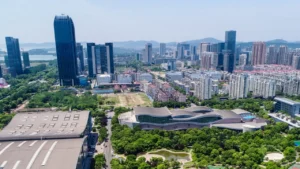The Benefits of Energy-Efficient Building Retrofitting Solutions: A Strategic Imperative for Sustainable Performance
In an era marked by tightening climate regulations, volatile energy markets, and increasing demands for ESG performance, energy-efficient building retrofits have emerged as one of the most cost-effective and high-impact strategies for transforming existing infrastructure into high-performing, future-ready assets.
Retrofitting is not just about replacing outdated equipment—it’s about optimizing energy use, reducing emissions, enhancing occupant comfort, and extending the functional life of a building. With commercial buildings accounting for up to 40% of global energy consumption and one-third of greenhouse gas emissions, the need for retrofitting is urgent, strategic, and measurable.
This article provides a detailed examination of the technical, financial, operational, and environmental benefits of energy-efficient building retrofitting, along with the key technologies, implementation approaches, and long-term outcomes that organizations can expect.
What is Building Retrofitting?
Building retrofitting refers to the process of upgrading the energy-related systems of existing buildings to improve performance, reduce energy use, and ensure compliance with updated regulations or certifications (such as LEED, BREEAM, Estidama, or local building codes).
Unlike renovations, which may focus on aesthetics or spatial reconfiguration, retrofitting prioritizes the building’s operational efficiency, indoor environmental quality, and long-term asset value.
Typical retrofitting measures include:
- Replacing outdated HVAC systems with high-efficiency models
- Upgrading insulation, windows, and glazing systems
- Converting lighting to LED with smart controls
- Installing building automation systems (BAS)
- Integrating renewable energy systems (e.g., solar PV, geothermal)
- Retrofitting chillers, boilers, and pumps with variable frequency drives (VFDs)
Core Benefits of Energy-Efficient Retrofitting
- Significant Reduction in Energy Consumption
One of the primary objectives of retrofitting is to reduce energy intensity (kWh/m²). Studies show that retrofitting can result in:
- 20%–50% reductions in annual energy consumption
- Decreased peak demand, lowering demand charges
- Reduced dependency on fossil fuel-based systems
Energy models and audits (such as ASHRAE Level 2 or 3) often form the basis of identifying the most impactful retrofitting opportunities, supported by performance simulation software.
- Lower Operating and Maintenance Costs
Efficient systems require less energy input and fewer maintenance interventions, translating to:
- Lower utility bills across HVAC, lighting, and plug loads
- Reduced downtime and repair costs
- Extended lifecycle of mechanical and electrical systems
- Fewer occupant complaints and service requests
By eliminating inefficiencies and implementing predictive maintenance technologies, buildings operate more smoothly and cost-effectively.
- Carbon Footprint Reduction and ESG Compliance
Retrofitting contributes directly to Scope 1 and Scope 2 emissions reductions, helping organizations align with:
- Corporate net-zero targets
- Carbon disclosure frameworks (CDP, GHG Protocol, TCFD)
- Regional carbon pricing mechanisms or green building mandates
In jurisdictions like the UAE and KSA, where energy intensity regulations and green building codes are tightening, retrofits can ensure compliance while improving ESG scores.
- Enhanced Indoor Environmental Quality (IEQ)
Retrofitting solutions often target improvements in:
- Indoor air quality (ventilation rates, CO₂ levels)
- Thermal comfort (zoning, insulation, glazing)
- Lighting quality (natural daylight integration, glare control)
- Acoustic control (upgraded windows, insulation)
These factors are linked to increased occupant satisfaction, productivity, and health—especially critical in schools, hospitals, and office environments.
- Asset Value Appreciation and Market Competitiveness
Energy-efficient buildings are increasingly seen as premium assets, attracting:
- Higher rental yields and occupancy rates
- Greater investor interest and due diligence alignment
- Green certifications that serve as market differentiators
In real estate markets, green-certified buildings often command up to 10% higher valuations and experience reduced vacancy risks, particularly in institutional portfolios.
- Regulatory Readiness and Risk Mitigation
Many governments are introducing mandatory benchmarking, energy performance disclosure, and retrofit requirements for existing buildings. By retrofitting early, building owners can:
- Avoid non-compliance penalties
- Access incentive programs and subsidies
- Prepare for stricter future energy codes and carbon limits
Moreover, retrofitting reduces the stranded asset risk for buildings that may become non-compliant or financially unviable in a low-carbon economy.
- Eligibility for Green Financing and Tax Incentives
Retrofitted buildings are more likely to qualify for:
- Green bonds or sustainability-linked loans
- Carbon credit revenue from verified energy reductions
- Tax incentives for renewable energy and energy efficiency upgrades
- Government-funded retrofit rebate programs
This creates a favorable investment cycle, where savings fund the retrofit and improved ESG positioning unlocks financial benefits.
Common Retrofitting Technologies and Solutions
Category | Solutions |
HVAC | High-efficiency chillers/boilers, VFDs, economizers, demand-controlled ventilation |
Lighting | LED retrofits, daylight sensors, occupancy sensors, dimming controls |
Building Envelope | Insulation upgrades, double/triple-glazed windows, thermal sealing |
Automation | Smart thermostats, BMS integration, predictive analytics |
Water Systems | Low-flow fixtures, leak detection, hot water system upgrades |
Renewables | Rooftop solar, solar thermal water heating, hybrid systems |
Energy Storage | Battery storage, thermal storage, integrated smart grid compatibility |
Implementation Process: Strategic Retrofitting in 5 Stages
- Preliminary Assessment
- Conduct ASHRAE Level 1 or 2 energy audit
- Define performance gaps and strategic priorities
- Feasibility and ROI Modeling
- Simulate retrofit scenarios
- Calculate payback, IRR, and lifecycle cost savings
- Design and Procurement
- Develop technical specifications
- Select technology providers, EPC contractors, or ESCOs
- Execution and Commissioning
- Schedule phased or full-system retrofit
- Test, balance, and commission all systems
- Monitoring and Optimization
- Integrate performance dashboards
- Track savings with IPMVP-compliant measurement and verification (M&V)
Overcoming Common Challenges
Upfront Capital Constraints
Solution: Leverage Energy Performance Contracting (EPC), where repayment is tied to achieved savings.
Disruption to Operations
Solution: Conduct retrofits in off-peak seasons or weekends; use modular or plug-and-play upgrades where possible.
Data Deficiency
Solution: Install smart meters and sub-metering systems to establish baseline energy use and post-retrofit comparison.
Technical Complexity
Solution: Partner with consultants who specialize in retrofit design and financing structuring—ensuring alignment with both performance and compliance goals.
Long-Term Strategic Impact
Impact Area | Strategic Benefit |
Operational | Reduced utility bills, optimized system performance |
Environmental | GHG emissions reduction, alignment with sustainability goals |
Financial | ROI-focused capital planning, increased asset value |
Social | Better occupant experience, improved health and productivity |
Regulatory | Compliance with evolving building codes and energy standards |
Final Thoughts
Energy-efficient building retrofits are not just a sustainability initiative—they are a business performance strategy. They deliver measurable results across operational, financial, environmental, and regulatory dimensions. In a landscape where buildings are expected to perform, not just exist, retrofitting is how forward-looking organizations secure future value.
Whether you manage commercial real estate, government facilities, or institutional infrastructure, a well-executed retrofit plan can position your assets for profitability, compliance, and climate resilience.
ECMC: Your Retrofit Strategy Partner
At ECMC, we provide integrated retrofitting advisory and execution support to help organizations:
- Evaluate retrofit potential through professional energy audits
- Design ROI-driven retrofit strategies
- Select technologies and partners with technical precision
- Monitor, verify, and report post-retrofit performance
Our team combines expertise in Energy Efficiency, Financial Compliance, and Environmental Consultancy to ensure every retrofit is not just a project—but a transformation.
Let’s build better—together.






